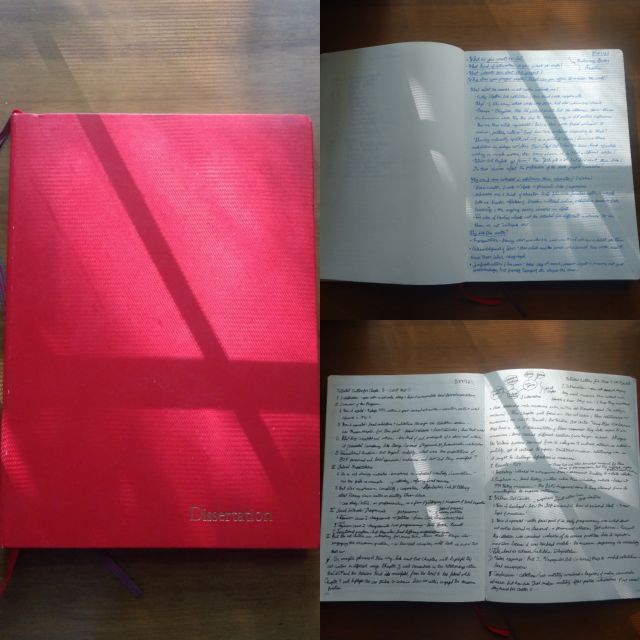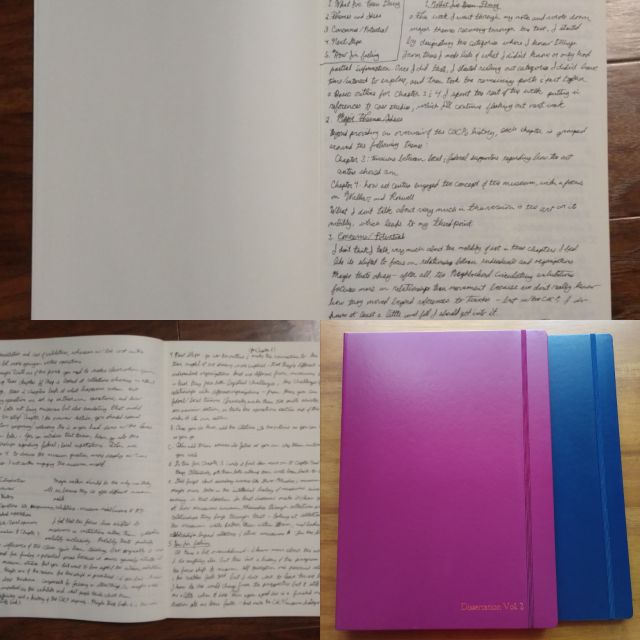Last September I experienced a milestone with my dissertation. No, I haven’t finished drafting it, far from it, but I did finish something that, to me at least, is significant: I filled the last page of my dissertation journal. Between the covers of that journal are two years’ worth of ideas, outlines, maps, and above all else, thinking.

I’ll be honest, until I started the dissertation I wasn’t really one for journaling. I’ve been given some beautiful journals over the years, from minimalist, hand-bound pieces to more baroque affairs with elaborately printed or textured covers, but more often than not, they go unused. I’ll usually start a journal, and sometimes I’ll stick to it for months, but eventually, I’ll taper off and leave it unfinished. Or even worse, I’ll get embarrassed by what I wrote and tear the pages out. The only time I’ve managed to complete a personal journal is when I spent a semester abroad as an undergraduate, and that’s because I was completely outside my normal routine and felt it warranted recording. Much as I cherish those memories though, I rarely reread the journal because I find the florid prose I used then pretentious and insufferable.
I’ve got a litany of excuses for why I don’t journal. A major reason has been that I found many of the journals I’ve been given too beautiful to sully with incomplete thoughts and mediocre handwriting. Another reason is that I don’t find my day-to-day life interesting enough to warrant recording in writing (sketching is another matter). Future historians might find my trips to the grocery store interesting, I suppose, but I don’t. Still another reason is that I’ll spend that time doing something else, usually sketching or knitting.
Really, the closest thing I have to a personal journal at this point is my blogging, which I’ve been doing on various platforms for ten years now. But the blog serves a public role that’s quite different from a private diary. I know other people read this, and as such it’s heavily edited, showing only the facets of my life I want you to see. When it comes to my innermost thoughts and feelings, at this point I prefer talking them out rather than writing them down.
All this is to say that journaling wasn’t a huge part of my life when I came to William & Mary, so getting a journal for my dissertation wasn’t on my radar.
What changed my mind was talking to my cohorts and seeing how journaling benefitted them. Through in-person conversations and seeing pictures on Instagram and social media accounts, I started understanding the benefits of having a space to think out your preliminary ideas before heading to the computer, a place to connect the mind and body through pen and paper. During my time with Keio, Ravynn Stringfield, director of the program, introduced me to some of the stationery shops in the area, most notably Jenni Bick in Washington, DC. As I started looking at the range of journals available, I decided to give journaling another try.
After finishing my comprehensive exams (and spending more hours than I care to admit looking at journals online), I ordered my first journal from Jenni Bick: a Leuchtteum 1917 Master Notebook. I picked this one because I liked the sturdy, durable construction and minimalist design, which I thought would help me get over my fear of sullying perfect pages with messy thinking and handwriting. I selected the largest size because I wanted lots of space to draw out idea maps, outlines, and reflections. Instead of lined pages, I chose dots, as I like the structure it provides while allowing more freedom for drawing and other techniques. And to further encourage big, bold ideas, I ordered it in fire engine red.

For two years, this journal has been my companion on my dissertation journey. It’s accompanied me on every research trip, giving me a space to record my experiences as they happen. It’s been a site for weekly reflections, letting me process the week’s work before typing them up. It’s also been an important space for the emotional work of dissertating, giving me a place to express feelings ranging from excitement to frustration. In short, it’s given me the space to work out both my ideas and my emotions.
So when I found myself coming to the final pages a few months ago, I couldn’t help but feel wistful. At the same time, I felt satisfied as I looked at all the filled pages. Right now, my dissertation and its research exist as electronic files. I know I’ve done a lot of work on it, but currently there’s little tangible evidence. Seeing the dissertation journal and all 234 of its extra large pages filled with writing is a tactile reminder that this project is very real, even if it doesn’t exist in the same physical realm as books. Not yet, at least.
But just because I’ve filled the dissertation journal doesn’t mean my journaling days are finished. On the contrary, I’ve found the journaling process so helpful to my working process that it’s extended into other parts of my life. I now use planners to organize my day and manage my objectives, and maintain journals for different projects, from article manuscripts to container gardening. I’ve become a regular customer at Jenni Bick, ordering quality pens and pencils in addition to journals to make my writing and reflecting even more enjoyable.

And I’m not finished with my dissertation journaling either. Shortly before I finished my first journal, I ordered a new one. While it’s in the same size, I opted for a slimmer volume because my journaling needs have changed. In the beginning, when I was working on the prospectus, I wrote a lot, sometimes daily, as I tried out different frameworks and ideas. Once I got the prospectus approved, my writing tapered off as my needs changed. Over time, the journal has shifted from being a space to generate ideas to refining them. Journaling is still important, but as the project evolves, so journaling about it has become more focused.
This is why the second journal is not in the same color. Instead of a bright red, I opted for a deeper, burgundy color. If the first journal was about the generation of big, bold ideas, the second one is about their refinement.
So now I’ve got a new companion to accompany me on these next stages of the dissertation journey. Let’s see what adventures we’ll experience.